We’re used to prophets being young, like Jeremiah and John the Baptist. As prophets, after all, their job is to look ahead. On the other hand, we think of elders as caretakers of the past. But Pope Francis asks us to see our elders looking ahead to the future. He gives us Simeon and Anna as our role models.
In his February 2014 homily on the Feast of the Presentation of the Lord, Pope Francis asked us to consider Anna and Simeon as senior citizen prophets. This older woman and man have just met the new parents Mary and Joseph bringing their baby Jesus to the Temple. “It is a meeting between young people who are full of joy in observing the Law of the Lord, and the elderly who are filled with joy for the action of the Holy Spirit,” Pope Francis preached. “It is a unique encounter between observance and prophecy, where young people are the observers and the elderly are prophetic!” Pope Francis frequently talks about the gift that older women and men are to their communities. They are not to be thrown away but cherished as valued members.
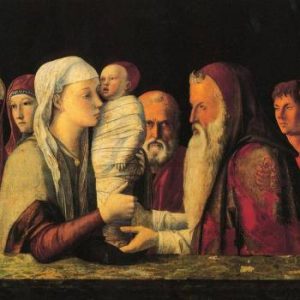
Before we get to the heroes of this story—the wise elders Simeon and Anna—we should reconsider this ancient but overlooked feast and its meaning. The Feast of the Presentation of the Lord recalls Jesus being presented to Yahweh’s service. But we can also look at this gospel scene through Pope Francis’ eyes to see Simeon and Anna, wise senior citizens, prophetically presenting Jesus as Messiah to the world.
An ancient feast
The Feast of the Presentation of the Lord falls on February 2, which is 40 days after Christmas. A holy day for Mary called her Purification was sometimes connected with its celebration. That span of 40 days after Christmas is the key. The number 40 relates to the Jewish custom found in the book of Leviticus (12:2-8). This rule stipulated that a woman who gave birth to a boy was ritually impure for 7 plus 33 days. This tradition continues in some Jewish communities where women have a ritual cleansing in a bath called a mikvah after menstruation or childbirth.
The Presentation of the Lord was observed in Jerusalem with sermons on Simeon and Anna as prophets of Jesus’ identity as the Messiah by the end of the fourth century. Through the Middle Ages, the celebration became associated with candles since Jesus is the light in the darkness. This feast was called Candlemas and was marked by the blessing of candles that were then carried in procession, sometimes emphasizing Jesus’ Presentation but in other times and locations marking Mary’s purification. After Vatican II, church officials overhauled the liturgical calendar to make it more historical. It is in this revised Roman Calendar, which regulates Roman Catholic liturgy today, that the Presentation of the Lord is celebrated on February 2.
The day celebrating Mary’s purification is now called the Memorial of Mary’s Presentation and assigned to November 21. It honors Mary as the temple in which the Lord would become human. The day commemorates an event that is not found in the gospels when, at the age of 3, Mary was brought by her parents to the Temple and consecrated or presented to Yahweh’s service. Mary’s parents aren’t named in the Bible, either, but legends call them Joachim and Anne.
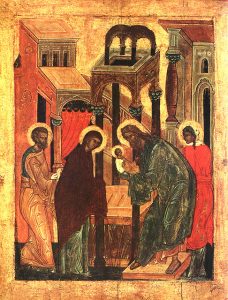
Biblically bridging the generation gap
An important point can be drawn from the history of tying Jesus’ presentation with Mary’s presentation or purification: Jesus and Mary are linked generationally. It is this link between one generation and the next one (or two or three) that Pope Francis has been focusing on, although he is not starting anything new. St. John Paul II urged older and younger people to bridge the generation gap between them. Pope Francis drew on his papal predecessor when he wrote in Amoris Laetitia: “Listening to the elderly tell their stories is good for children and young people; it makes them feel connected to the living history of their families, their neighborhoods and their country.”
Simeon and Anna bridge this generation gap when they play the role of prophets to all succeeding generations. If we recall the excitement of bringing a child to church for baptism today, we likely touch the feelings that Mary and Joseph had when approaching the Temple with a baby not even seven weeks old. They had faith in the angel’s promise to them of the role this special child would play, but surely they were nervous about being caretakers of the Messiah. Anna and Simeon are not blood relations to Mary or Joseph, but they say amazing things that must have touched these new parents deeply.
The scene is recounted only in Luke 2:25-38, which is the gospel passage read on February 2, the Feast of the Presentation of the Lord. Joseph and Mary, following Jewish law, take Jesus to the Temple to be consecrated to Yahweh’s service as their first-born son. They bring the prescribed sacrifice of a pair of young pigeons or turtledoves. Simeon is not given an age, but we know that he is waiting for his death. At the same time, Yahweh had told Simeon that he’d live to see the Messiah. Luke describes Simeon as “righteous and devout, awaiting the consolation of Israel, and the Holy Spirit was upon him.” As soon as Simeon caught sight of them, he realized that Jesus was the promised Messiah. In a lovely scene repeated in homes and hospital rooms around the world, this old man cuddled that tiny baby in his arms. He looked up to God and said, “Now, Master, you may let your servant go in peace, according to your word, for my eyes have seen your salvation.”
Nearby stood Anna, who is identified as a prophetess and 84 years old. She fasted and prayed in the Temple all the time, reminding us of many retired men and women who now have time to spend in prayer or community service. Anna overheard Simeon speaking with Jesus’ parents—and she couldn’t keep the good news to herself. “She gave thanks to God and spoke about the child to all who were awaiting the redemption of Jerusalem.”
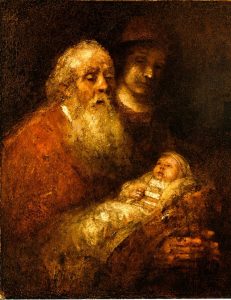
But did anyone listen to these old people or were they dismissed as fools? The German scripture scholar and religious reformer Martin Luther addressed this very question. Luther preached on this scene from Luke’s gospel in a sermon he delivered in 1522. There he praised Anna as full of the Holy Spirit. Though the people around them may have dismissed Anna and Simeon as old fools, Luther stressed how prophetic, bold, and wise they were. “Now it must excite wonder that such things were proclaimed openly by Simeon in that public and sacred place with reference to that poor and insignificant child…when nothing as yet was known of Jesus.” As for Anna, “full of wisdom and having a good conscience,” Luther says that she “must signify those who stand by and hear this message assenting to it and applying it to themselves.”
Simeon and Anna teach us several spiritual lessons. They teach us to keep praying. They teach us to have faith that God’s timing is not our timing. They teach us to have trust even if God’s promise is taking longer than we’d like. Finally, they teach that when we hear good news, we can’t keep it to ourselves. Even at the end of their lives, these two prophetic senior citizens were still paying it forward.
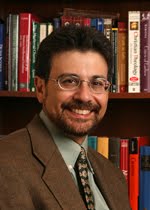 Christopher M. Bellitto, Ph.D., is Professor of History at Kean University in Union NJ. His latest book is Ageless Wisdom: Lifetime Lessons from the Bible (Paulist Press).
Christopher M. Bellitto, Ph.D., is Professor of History at Kean University in Union NJ. His latest book is Ageless Wisdom: Lifetime Lessons from the Bible (Paulist Press).
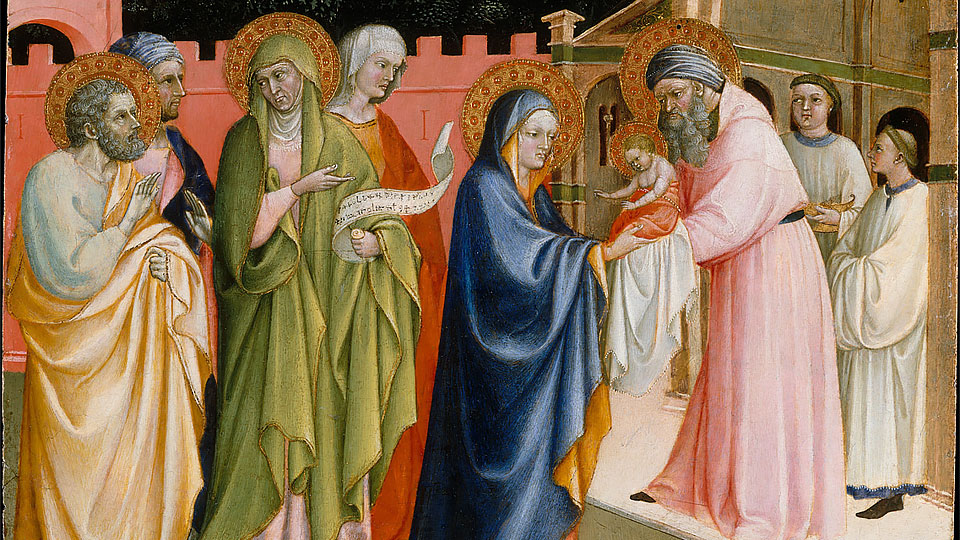
 Before we get to the heroes of this story—the wise elders Simeon and Anna—we should reconsider this ancient but overlooked feast and its meaning. The Feast of the Presentation of the Lord recalls Jesus being presented to Yahweh’s service. But we can also look at this gospel scene through Pope Francis’ eyes to see Simeon and Anna, wise senior citizens, prophetically presenting Jesus as Messiah to the world.
Before we get to the heroes of this story—the wise elders Simeon and Anna—we should reconsider this ancient but overlooked feast and its meaning. The Feast of the Presentation of the Lord recalls Jesus being presented to Yahweh’s service. But we can also look at this gospel scene through Pope Francis’ eyes to see Simeon and Anna, wise senior citizens, prophetically presenting Jesus as Messiah to the world.
 But did anyone listen to these old people or were they dismissed as fools? The German scripture scholar and religious reformer Martin Luther addressed this very question. Luther preached on this scene from Luke’s gospel in a sermon he delivered in 1522. There he praised Anna as full of the Holy Spirit. Though the people around them may have dismissed Anna and Simeon as old fools, Luther stressed how prophetic, bold, and wise they were. “Now it must excite wonder that such things were proclaimed openly by Simeon in that public and sacred place with reference to that poor and insignificant child…when nothing as yet was known of Jesus.” As for Anna, “full of wisdom and having a good conscience,” Luther says that she “must signify those who stand by and hear this message assenting to it and applying it to themselves.”
Simeon and Anna teach us several spiritual lessons. They teach us to keep praying. They teach us to have faith that God’s timing is not our timing. They teach us to have trust even if God’s promise is taking longer than we’d like. Finally, they teach that when we hear good news, we can’t keep it to ourselves. Even at the end of their lives, these two prophetic senior citizens were still paying it forward.
But did anyone listen to these old people or were they dismissed as fools? The German scripture scholar and religious reformer Martin Luther addressed this very question. Luther preached on this scene from Luke’s gospel in a sermon he delivered in 1522. There he praised Anna as full of the Holy Spirit. Though the people around them may have dismissed Anna and Simeon as old fools, Luther stressed how prophetic, bold, and wise they were. “Now it must excite wonder that such things were proclaimed openly by Simeon in that public and sacred place with reference to that poor and insignificant child…when nothing as yet was known of Jesus.” As for Anna, “full of wisdom and having a good conscience,” Luther says that she “must signify those who stand by and hear this message assenting to it and applying it to themselves.”
Simeon and Anna teach us several spiritual lessons. They teach us to keep praying. They teach us to have faith that God’s timing is not our timing. They teach us to have trust even if God’s promise is taking longer than we’d like. Finally, they teach that when we hear good news, we can’t keep it to ourselves. Even at the end of their lives, these two prophetic senior citizens were still paying it forward.
 Christopher M. Bellitto, Ph.D., is Professor of History at Kean University in Union NJ. His latest book is Ageless Wisdom: Lifetime Lessons from the Bible (Paulist Press).
Christopher M. Bellitto, Ph.D., is Professor of History at Kean University in Union NJ. His latest book is Ageless Wisdom: Lifetime Lessons from the Bible (Paulist Press).